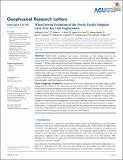Files in this item
Wind-driven evolution of the North Pacific subpolar gyre over the last deglaciation
Item metadata
| dc.contributor.author | Gray, William Robert | |
| dc.contributor.author | Wills, Robert CJ | |
| dc.contributor.author | Rae, James William Buchanan | |
| dc.contributor.author | Burke, Andrea | |
| dc.contributor.author | Ivanovic, Ruza F | |
| dc.contributor.author | Roberts, William HG | |
| dc.contributor.author | Ferreira, David | |
| dc.contributor.author | Valdes, Paul J | |
| dc.date.accessioned | 2021-03-17T00:38:39Z | |
| dc.date.available | 2021-03-17T00:38:39Z | |
| dc.date.issued | 2020-03-17 | |
| dc.identifier | 266604554 | |
| dc.identifier | 59536cf2-40d3-4a79-9607-d58672d1c08e | |
| dc.identifier | 85082527819 | |
| dc.identifier | 000529097700012 | |
| dc.identifier.citation | Gray , W R , Wills , R CJ , Rae , J W B , Burke , A , Ivanovic , R F , Roberts , W HG , Ferreira , D & Valdes , P J 2020 , ' Wind-driven evolution of the North Pacific subpolar gyre over the last deglaciation ' , Geophysical Research Letters , vol. 47 , no. 6 , e2019GL086328 . https://doi.org/10.1029/2019GL086328 | en |
| dc.identifier.issn | 0094-8276 | |
| dc.identifier.other | ORCID: /0000-0002-3754-1498/work/70919965 | |
| dc.identifier.other | ORCID: /0000-0003-3904-2526/work/70919966 | |
| dc.identifier.uri | https://hdl.handle.net/10023/21638 | |
| dc.description | Funding: UK Natural Environment Research Council (NERC) grant NE/N011716/1 (JWBR and AB). Tamaki Foundation, NASA (Grant NNX17AH56G), and NSF (Grant AGS-1929775) (RCJW). NERC Independent Research Fellowship NE/K008536/1 (RFI). | en |
| dc.description.abstract | North Pacific atmospheric and oceanic circulations are key missing pieces in our understanding of the reorganisation of the global climate system since the Last Glacial Maximum (LGM). Here, using a basin‐wide compilation of planktic foraminiferal δ18O, we show that the North Pacific subpolar gyre extended ~3° further south during the LGM, consistent with sea surface temperature and productivity proxy data. Climate models indicate that the expansion of the subpolar gyre was associated with a substantial gyre strengthening, and that these gyre circulation changes were driven by a southward shift of the mid‐latitude westerlies and increased wind‐stress from the polar easterlies. Using single‐forcing model runs, we show that these atmospheric circulation changes are a non‐linear response to ice‐sheet topography/albedo, and CO2. Our reconstruction indicates that the gyre boundary (and thus westerly winds) began to migrate northward at ~16.5 ka, driving changes in ocean heat transport, biogeochemistry, and North American hydroclimate. | |
| dc.format.extent | 14133130 | |
| dc.language.iso | eng | |
| dc.relation.ispartof | Geophysical Research Letters | en |
| dc.subject | North Pacific | en |
| dc.subject | Deglaciation | en |
| dc.subject | Gyre circulation | en |
| dc.subject | Westerlies | en |
| dc.subject | Oxygen isotopes | en |
| dc.subject | Climate models | en |
| dc.subject | QC Physics | en |
| dc.subject | QE Geology | en |
| dc.subject | DAS | en |
| dc.subject | SDG 13 - Climate Action | en |
| dc.subject.lcc | QC | en |
| dc.subject.lcc | QE | en |
| dc.title | Wind-driven evolution of the North Pacific subpolar gyre over the last deglaciation | en |
| dc.type | Journal article | en |
| dc.contributor.sponsor | NERC | en |
| dc.contributor.institution | University of St Andrews. School of Earth & Environmental Sciences | en |
| dc.contributor.institution | University of St Andrews. St Andrews Isotope Geochemistry | en |
| dc.identifier.doi | 10.1029/2019GL086328 | |
| dc.description.status | Peer reviewed | en |
| dc.date.embargoedUntil | 2021-03-17 | |
| dc.identifier.grantnumber | NE/N011716/1 | en |
This item appears in the following Collection(s)
Items in the St Andrews Research Repository are protected by copyright, with all rights reserved, unless otherwise indicated.

